A Swordfish with D-Day Stripes – Trumpeter 1/32 Swordfish Mk.II
Most of the Swordfish aircraft produced during the Second World War were constructed by Blackburn Aviation, including all Swordfish Mks. II and III. This situation must have felt good to Fairey Aviation - the company responsible for the original design - inasmuch as the two had been locked in competition throughout the 1920s and 1930s as suppliers of aircraft to the Fleet Air Arm. Blackburn producing the Swordfish would have been the equivalent of Chance Vought having to produce Grumman Hellcats because they had no Corsair. The Swordfish built by Blackburn were nicknamed "Blackfish."
The ungainly-looking Swordfish - a biplane that was obsolete at the time of its first flight as a prototype in 1934 - was in fact the most successful naval strike aircraft of the Second World War. The strike against the Italian fleet at Taranto inspired the Japanese attack at Pearl Harbor, while the "Bismarck" pursuit, and "The Channel Dash" are epic actions, as a result of which the Swordfish passed into legend.
What is less well-known but perhaps more important than all of these epic battles combined was the day-to-day work of the Swordfish during the Battle of the Atlantic. From 1940 to 1945, the Fleet Air Arm sank 18 Axis submarines and shared 16 other sinkings with escort vessels or RAF units. The Swordfish was responsible for 15 of the 18 solo kills, and participated in 10 of the 16 shared sinkings - and it didn't even enter the Battle of the Atlantic until February 1943! That is quite a record. Even more important than the submarines sunk were the merchant ships successfully escorted across the Atlantic. The Swordfish was like the loyal shepherd's dog that protects the flock not by killing the wolves that follow the defenseless sheep, but by keeping them at bay.
The Swordfish first went aboard the escort carrier H.M.S. "Biter" in February 1943. Later that year the first MAC ships - converted grain ships or tankers that were even smaller than the CVEs, with no below-decks hangar space to get the 4-6 aircraft they carried out of the weather for maintenance or protection - began operations. The Swordfish was famous for being able to stagger off these decks in weather conditions that kept other aircraft tied down for safety, and for bringing its crews back to small, short decks pitching through 20-30 feet while rolling 10-15 degrees from vertical to either side, in North Atlantic storms where the freezing level was at 500 feet. Escorting Archangel convoy RA-58 in April 1944, Swordfish of 819 Squadron flew from H.M.S. "Activity," while Avengers of 846 Squadron - the premier F.A.A. Avenger sub-hunting squadron - flew from H.M.S. "Tracker." The Swordfish flew every day of the trip, even on days when 846's Avengers couldn't even be brought on deck to attempt a launch.
The Swordfish that accomplished all this was the Mk.II, a progressive modification of the original Mk.I, that was primarily distinguishable by a slightly more powerful engine and its strengthened lower wings, the lower surfaces of which were metal covered. These wings were fitted to the Swordfish starting with W5836, which also utilized the more powerful Pegasus 30 engine, for the remainder of the Blackburn production run. Late-production Swordfish IIs and all Swordfish IIIs are distinguishable by an enlarged oil cooler on the starboard forward fuselage for this engine.
The aircraft had been experimentally equipped with radar in 1941. By 1943, all Swordfish II carried early ASV radar, with the Mk.III - which entered service in late 1943 - carrying centimetric air-to-surface radar in a radome between the landing gear.
The Swordfish first successfully fired rockets during tests in October, 1942. The Swordfish took rockets into action in 1943, with the first successful use of rockets against a U-boat occurring on May 23, 1943, when a Swordfish of 811 Squadron flown by Sub-Lt. Horrocks pierced the hull of U-752, which subsequently sank after further attacks by Wildcats and a bomb-carrying Swordfish. The last contact between a Swordfish and a U-boat occurred on April 20, 1945.
Tamiya released a Swordfish I in 2000 that is considered one of the best injection-plastic kits ever released. The good news here is that Trumpeter has essentially pantographed the Tamiya kit up to 1/32 scale. The surface detail is a bit more accentuated than the Tamiya kit, and there are no underwing racks or ordnance provided, but this is not a problem. The kit also follows the Tamiya kit in not having separate Handley-Page slats on the upper wings.
Essentially, this Swordfish Mk. II kit is the same as the earlier Swordfish I kit, other than for lower wing parts that do not have fabric effect since they are metal-covered, and with an additional sprue that includes the larger oil cooler. Underwing ordnance, in the form of three 250-lb bombs and racks, or eight rocket projectiles and launch rails, along with the centerline torpedo and the outboard flare racks, are included. The kit does not include the radar gear for the cockpit, or the radar antennas, so the fastidious modeler who wants technical accuracy will either have to use some part from the spares box and do a little scratchbuilding of the antennas, for accuracy.
Decals are included for a Swordfish II night bomber in Extra Dark Sea Grey/Dark Slate Grey/Night camouflage and an Atlantic-scheme airplane. Fortunately, Xtradecals released sheet 32-026, which provides markings Swordfish II aircraft operated by 810 Squadron in Madagascar in the standard scheme, a “Channel Dash” Swordfish from 825 Squadron, a Swordfish in D-Day markings from 816 Squadron, and another Atlantic-scheme airplane from 836 Squadron. I chose to do the 816 Squadron airplane, so I could do an obsolete biplane in D-Day markings armed with radar and rockets, a true anachronism.
The Tamiya Swordfish is one of the best-designed plastic kits ever produced, and Trumpeter intelligently decided to upgrade that kit to 1/32. Thus, all a modeler needs to do to insure a beautiful result is follow the instructions. The one place where problems may ensue is the attachment of the cockpit interior to the right side fuselage part. Be very careful here in insuring the sub-assembly is aligned perfectly. If you do so, the fuselage will snap together so good it won't really need any Mr. Surfacer or other filler on the centerline.
My one deviation from an out of the box build was to cut the leading edge slats off the upper wing and then attach them in the open position, which was the way they were on all Swordfish sitting on the ground. This is easy. You cut off the parts, glue upper and lower parts together, then sand the interior of the slat so that it has a sharp trailing edge. Evergreen sheet can be used to fill in the gap in the wing, and can also be used for the three extension arms. It's an easy fix and the kit looks far more accurate once assembled with the slats open. I also made the radar antennas from Evergreen rod.
The “Atlantic Scheme” with the fuselage sides, vertical fin and rudder, and lower surfaces of the wings and tail painted white appears from photos to have been done after the airplanes left the factory, with the white applied over the standard FAA camouflage. Since the kit is in grey plastic, I applied Xtracrylix White to these areas, without getting a uniform, fully opaque coat. Thus the darker color under the white can be “seen” to varying degrees. This has to be done subtly, and what you want is the finish you get just before you get full coverage airbrushing the white. I also painted the upper surfaces of the wings, and masked those areas to complete the D-Day stripes. I let that dry and then applied Xtracrylix Extra Dark Sea Grey and Dark Slate Grey, with a very little bit of lightening of each color for “post shading” once the main color was applied.
There is no getting around the fact that the Swordfish was very far indeed from being a beautiful biplane. However, it is living proof that beauty is as beauty does. The Swordfish was one of four British aircraft in first line service in 1939 that were still in first-line service at the end of the war (the others being the Hurricane, the Wellington and the Spitfire). It outlasted its replacement and in many ways outperformed the Avenger in the anti-submarine role, performing its tasks under appalling conditions in which no other airplane could have operated. It fully deserves its status as one of the truly legendary aircraft of the Second World War. The Swordfish is a biplane that even those who cringe at the very thought of building a biplane can complete without trouble.
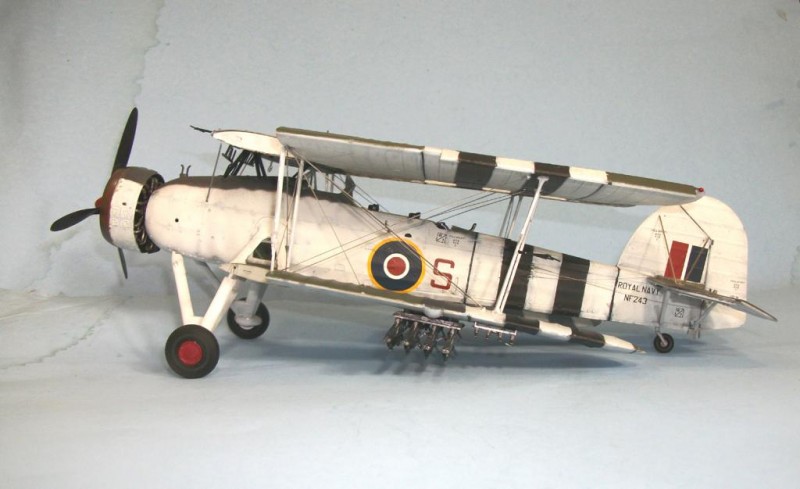
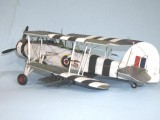

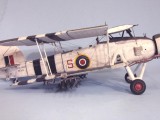
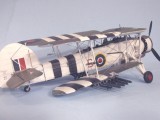
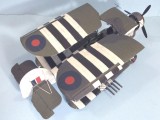
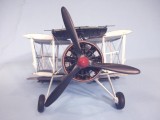



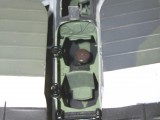
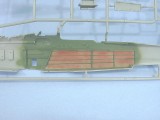
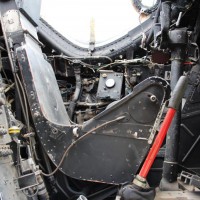

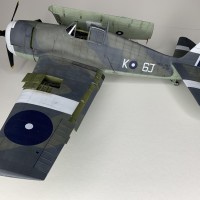
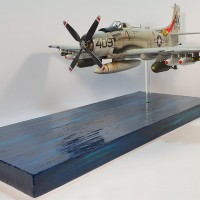
Nice presentation, Tom.
I built the 1/48 version and found it 'good in parts.' Tamiya appear to prefer the kit to be built wings folded, where the two sets of wings are treated as port/starboard modules. I built against type with the wings extended, and had to overcome several problems. However, the kit included a great set of crew figures, and the whole thing looked quite smart when eventually complete.
I posted photos of it on a Headlines tab some time ago I think, by way of comparison to the 1/32 version.
Nice to see some Fleet Air Arm representation here.
Very Nicely done,
A very nice build and a long and interesting text ! Well done. The right stuff
to read on a rainy sunday.
I don t know, why i never touched my Tamiya Swordfish.
Bernd
Love it. Go the FAA.
Very nice build, must be spectacular on the display shelf in 1/32 scale. Very impressed with your paintwork on the exhaust, hot metal blueing. An extraordinary aircraft, some very brave crews took to the air in the "Stringbag". The new Airfix 1/72 kit "re-tool" is very nice I think, looks basically like a scaled down 1/48 kit.
Great build Tom, I did not know that the Trumpeter kit was the Tamiya kit sized up.
Tom,
Beautifully done. The Stringbag is like so many other British type aircraft, It is so ugly it is beautiful. Don't jump on me Mate's, that is a compliment. I built three of the Tamiya kits and they are fabulous.
Tom,
Very nice job on what looks like a difficult kit to me. I like the way you applied the white up to just before you got full coverage. It really looks "right". That must be a big model when finished, and probably more manageable to have the wings folded. Many thanks!
The kit is really no more difficult than the Tamiya kit, other than swinging it around, size-wise. You have the choice of wings folded or spread, one or the other.
Are those wings moveable, or does one have to decide upon which option to use...?
Craig it's Either/or on the wings. You get a set of spars for the extended wings and a Rib&mount piece for the folded wings. (Basically the same as Tamiya's 1/48 kit.) I have the 1/32 kit (mk1) myself and am building a prewar silver machine from Ark Royal in 1938 (has luvverly red and blue banding!) I also have 2 mk 1's in 1/48 on the go, a standard and a floatplane.
Impressive Tom and I really enjoyed the history lesson. I knew of some of the early war achievements but had no idea that it served right to the end of the war. Never imagined a D-Day striped Stringbag! Really like the finish and especially like the overhead view on photo #6. Sitting like a coiled up snake waiting to strike.
Most impressive facts about the Swordfish: The speed difference between takeoff, cruising and top speed was a range of 30mph!
It was so slow that the only way a single engined fighter like the 109 could get a clear shot at it before overshooting, was the drop his flaps and U/C and throttle back to almost stalling. Which made him an easy target for the gunner & if he used the cannon, the recoil was enough to cause a stall!
Nice clean build, great info on the plane's exploits.
Great work Tom. I'm building the Mark 1 kit myself and second all your comments. Note that, unlike Tamiya, Trumpeter do include the PE rigging in the kit. The only AM work I have is a set of Mastercasters wheels- the rubber tyres in the kit are treaded, which was not common during the war. The MC Wheels have smooth tyres, which was standard as the Stringbag operated from either a carrier or a grass/earth field by and large.
Looks really impressive Tom - great markings and interesting write-up as well.